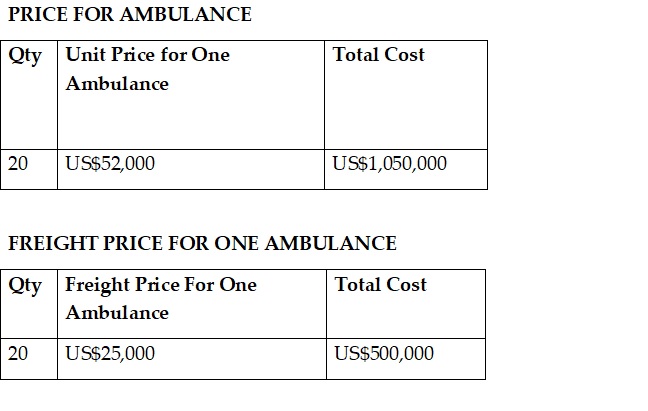As Kawusu Kebbay faces the Justice Biobele Commission of Enquiry today, startling revelations continue to emerge around the purchase of twenty ambulances by the Government of Sierra Leone.
What has become clearer by the day, based on the email authored by Kawusu Kebbay, is that the Ministry of Health had actually purchased hard top vehicles in Dubai instead of ambulances for a lesser amount than what they made the people of Sierra Leone to believe.
Kawusu Kebbay has indicated, in his email sent to the rest of the officials at the Emergency Operations Centre in Freetown in August, 2014, that:
“I inspected all twenty vehicles that are ready, although ten are fully fitted with necessary equipment. Five have been committed to Liberia. Now we need to move or else we will delay further. It takes an average of one day to get one unit fully fitted. However with the advance they have agreed to let their staff work extra time and reduce the fitting time by half…”
What was there to fix in the ambulances? What Mr. Kawusu has simply done, as he had indicated above, was to buy hard top vehicles, costing around US$30,000 compared to the US$77,000, which each ambulance has costed the Government of Sierra Leone including freight price.
These hard top vehicles were later fixed with the necessary gadgets and shipped to Sierra Leone.
Kawusu’s meeting with two contractors, as further stated in his email, also clearly indicated that the Government of Sierra Leone had actually transacted the ambulance contract with two companies (Kingdom Security Logistics and UNIWORLD Enterprises) with one supplying the vehicles and the other supplying the gadgets used to fix the vehicles.
The Ministry of Health also made us to believe, based on Kawusu Kebbay’s email, that all twenty ambulances costed the Government of Sierra Leone US$1,050,000, excluding the freight price which they exorbitantly tagged at US$25,000 each.
Combining the freight price of each ambulance, which cost US$25,000 each by Kawusu’s email, it will reasonably increase the price of the twenty ambulances to US$77,000 each. Hence the total cost for all twenty ambulances is US$1,540,000 as compared to the US$1,050,000.
So it is very evident that Kawusu Kebbay and the Ministry of Health (EOC) have paid little less for the hard top vehicles and its accompanying gadgets rather than what they made Sierra Leoneans to believe.
The Emergency Operations Centre therefore has to account for over US$660,000, an equivalent of Le5, 667, 000, 000 (five billion, six hundred and sixty seven million). The market price for hard top vehicles stands at US$30,000 and calculating the price for all sixteen hard top vehicles supplied to the government of Sierra Leone it will cost US$480,000.
Going by the estimated freight price for all sixteen hard top vehicles, brought to the country as indicated in the email, gives us another US$400,000.
Therefore the Government of Sierra Leone could have simply spent the sum of US$880,000 with no middle men involved, instead of the US$1,540,000, which Government has spent on the purchase.
Reacting to questions from the Commissions of Inquiry in his last appearance, Kawusu Kebbay and his legal team had made Sierra Leoneans to believe he only travelled to Dubai to inspect the vehicles on behalf of Government. We are tempted to ask a series of questions. For example, in which capacity was he chosen to inspect the ambulances when there are established state structures in Government to handle such technical matters?
The Ministries of Transport and Health, under which such procurement was done, have technical people charged with inspecting vehicles procured by Government in order to ascertain their durability and other factors relating to the procurement of such related factors.
What was the motive of leaving all these established structures and recruit Kawusu Kebbay to perform such a function?
The defence team for Kawusu Kebbay and co keep flip flopping in their attempt to defend Kawusu Kebbay and other persons of interest involved in the Ebola Ambulance saga.
They have previously maintained, in the Commissions’ hearings, that their client had never travelled to Dubai to the point that he even produced travelling documents. The other day they conceded that he had only travelled to inspect the vehicles. The same defence team had also boasted in the last COI hearings that their client had saved government US$50,000 in the said contract.
How can he save such money for a government when his defence had claimed that he was not directly involved in any monetary transaction?
See the attached calculations on what has transpired in the ambulance saga based on Kawusu Kebbay’s revelations.
Note: A total of US$1,540,000 was spent on purchasing the twenty ambulances although sixteen were later supplied.
The below table shows what government could have simply spent. We have also used the established freight as stated in the email
Note: Government would have spent $880,000 on purchasing the sixteen vehicles supplied to government, including directly bringing them home without the involvement of rogue middle men.
